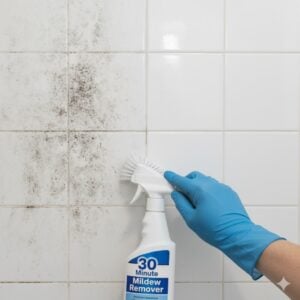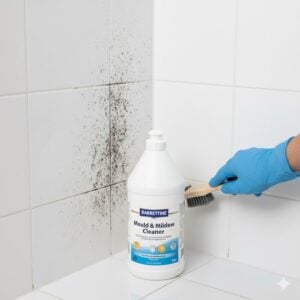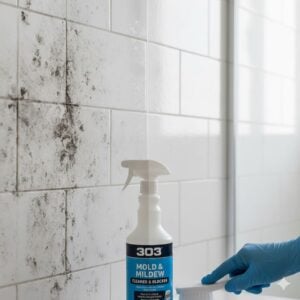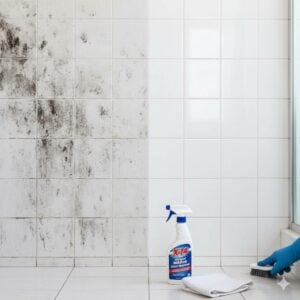Not all mold shows itself in dark black spots or fuzzy green patches. In many UAE homes, especially in humid areas like Dubai or Sharjah, mold stays hidden inside walls, air ducts, or behind furniture. The only clue it’s there? Your body’s reaction to it.
From chronic coughing to itchy skin and constant fatigue, mold symptoms are often misdiagnosed as allergies, the flu, or even stress. But if you feel better outside your home than inside it—there’s a chance mold is to blame.
In this article, we’ll explain what mold symptoms are, who’s at risk, and what to look out for. If you live in a home with poor ventilation, musty smells, or recent water leaks, it’s worth reading carefully.
Table of Contents
Toggle1. What Are Mold Symptoms and Who Gets Affected?
Mold symptoms are physical reactions caused by breathing in or touching mold spores. These spores are tiny particles released by mold growth in your home—and they float in the air, land on fabrics, and enter your air conditioning system.
While anyone can experience symptoms, certain people are more likely to suffer:
- Children with developing lungs or frequent exposure
- Elderly residents with weaker immune systems
- Asthma and allergy sufferers
- People with autoimmune conditions
- Pregnant women or newborn babies
The symptoms may start mild—like sneezing or watery eyes—but with daily exposure, they can become more serious. And because mold is often hidden, people don’t make the connection right away.
2. Most Common Symptoms of Mold Exposure
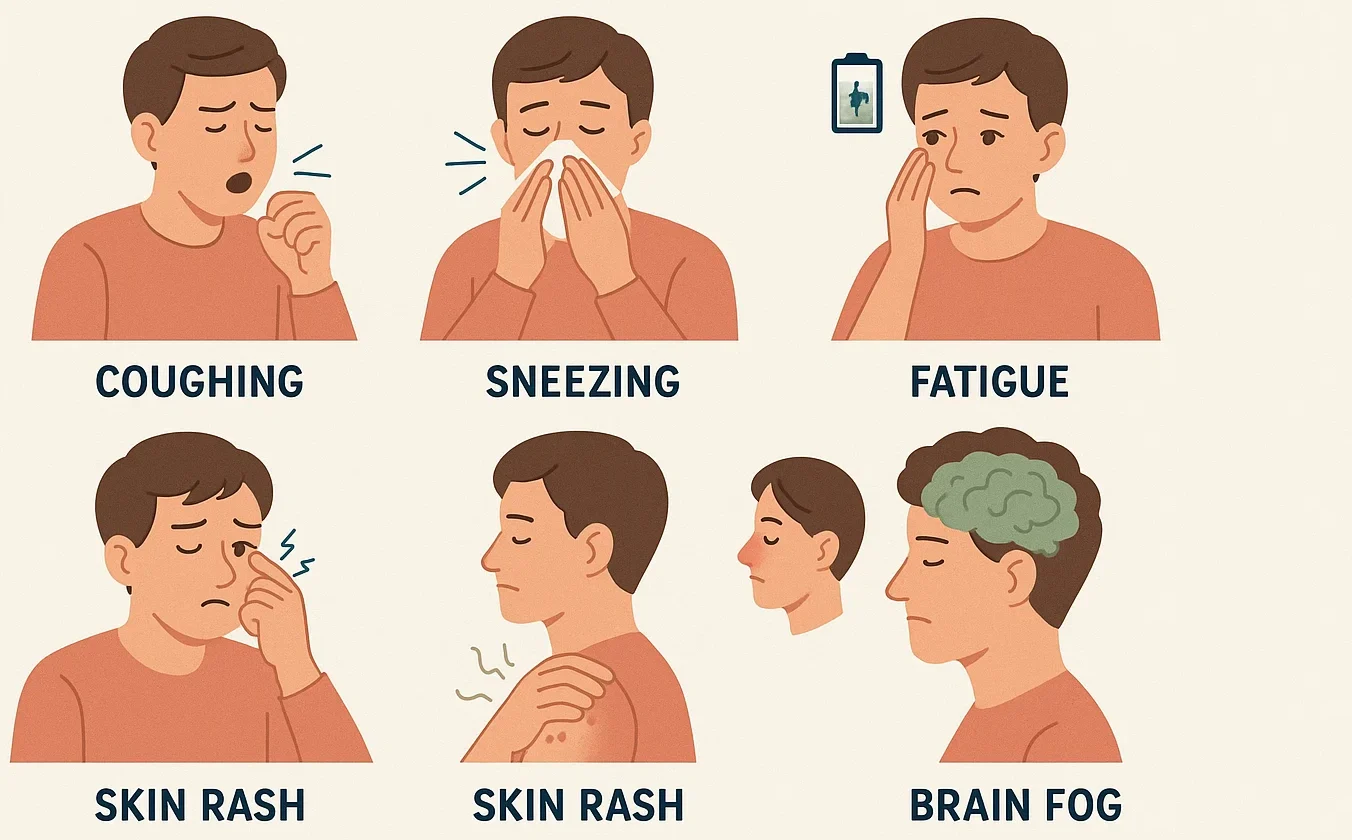
If you notice any of these symptoms regularly at home but not when you’re outside or at work, mold could be the cause:
- Sneezing and nasal congestion: Especially in the morning or when using the AC.
- Itchy, watery eyes: Not caused by perfume or dust, but something lingering in the air.
- Dry cough or sore throat: Persistent even without a cold.
- Shortness of breath or wheezing: May worsen with humidity or at night.
- Unexplained headaches and brain fog: Trouble concentrating, especially at home.
- Constant fatigue or poor sleep: Mold exposure can affect your nervous system over time.
- Rashes or skin irritation: Especially after contact with walls, clothing, or furniture in damp rooms.
One major warning sign? You feel better after leaving home. Many residents report a clear improvement in symptoms when they stay elsewhere or travel—only to feel sick again once they return. If that sounds familiar, don’t ignore it.
3. Where Mold Hides and Why You May Not See It
One of the biggest challenges with mold is that it often stays invisible. You might be looking for green or black spots—but many times, mold hides in places you can’t easily see. In homes across Dubai, Sharjah, and other Emirates, common mold hiding spots include:
- AC ducts and filters: Mold grows inside vents where condensation collects, then spreads spores through the entire house.
- Under carpets and behind beds: Especially in ground-floor flats or villas with poor airflow.
- Inside wardrobes and closets: Clothes may develop a musty smell even if freshly washed.
- Behind walls and ceilings: After pipe leaks, AC unit drips, or roof damage.
- In bathrooms and laundry rooms: Areas with high humidity and poor ventilation.
Even if you don’t see mold, a lingering musty or earthy smell is often the first clue. Some homes “just smell damp”—that’s often a sign of mold under the surface.
Because these areas are out of sight, people often suffer symptoms for weeks or months before realizing mold is the problem. That’s why professional inspection is crucial when symptoms persist without an obvious cause.
4. Why Ignoring Mold Symptoms Can Be Dangerous
It’s easy to dismiss sneezing or tiredness as everyday issues—but long-term mold exposure can lead to serious health risks, especially in sensitive individuals. Here’s what happens if the problem is ignored:
- Respiratory problems: Mold spores inflame the lungs, causing chronic asthma, bronchitis, or infections.
- Skin issues: Contact with moldy furniture or clothing can trigger rashes, eczema, or itchy bumps.
- Sinus infections: Persistent congestion can turn into bacterial infections needing antibiotics.
- Fatigue and mental fog: Mold affects the nervous system, leading to low energy and poor focus.
- Compromised immunity: Mold toxins can weaken your body’s defense system over time.
In children and the elderly, mold exposure is even more dangerous. It can affect development, sleep quality, and increase the risk of respiratory failure in severe cases. If multiple family members are always sick at home, mold could be the hidden trigger.
5. What to Do If You Suspect Mold in Your Home
If any of the symptoms above sound familiar, don’t panic—but don’t ignore it either. Here’s what you can do:
- Observe the pattern: Do symptoms improve when you’re away from home?
- Check for moisture: Look near AC vents, bathrooms, or anywhere with past leaks.
- Use a dehumidifier: Reducing indoor humidity can slow mold growth temporarily.
- Try safe surface cleaning: Wipe moldy spots with vinegar or anti-mold wipes—but wear gloves and don’t over-scrub dry mold (it releases spores).
- Call for a professional inspection: If there’s mold you can’t see or smell won’t go away, experts can detect the source safely and treat it fully.
At Bio-On UAE, we offer fast, discreet, and eco-friendly mold assessments across all Emirates. Our team uses moisture meters, thermal cameras, and HEPA equipment to find and remove mold—so you can breathe easy again.
Need help? Just click the contact button on the right-middle of this post. We’re here for you 24/7.
Conclusion
Mold symptoms are more common than most people realize, especially in warm and humid environments like Dubai. From sneezing fits to brain fog, your body might be reacting to hidden mold even if you don’t see it yet. And while a musty smell or some visible spots are clear signs, it’s the subtle health changes that often go unnoticed for too long.
If you or your family feel better outside the home than inside, it’s worth investigating. Don’t wait until the symptoms get worse or become chronic. At Bio-On UAE, we help residents across the Emirates find and fix the source of mold—safely, thoroughly, and discreetly.
Just click the contact button on the right-middle of this post, and let’s make your home a healthier place to breathe again.









